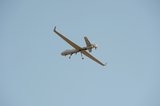Simulated near miss helps aircraft think like pilots
Researchers from British universities and industry have successfully tested technology that allows an unpiloted aircraft to autonomously detect and avoid collision with another aircraft, in an important step towards proving the safety of unmanned air vehicles.
The “sense and avoid” trial, which took place in the skies over North West England, involved two Jetstream passenger aircraft and was a convincing demonstration of how technology can replace the eyes and decision-making powers of a human pilot.
The research programme involved Cranfield and Lancaster Universities and BAE Systems, and was so successful it has just received a special award for “outstanding achievement” at The Engineer magazine’s Technology and Innovation Awards. The test flight used BAE Systems’ Jetstream Flying Test Bed airborne laboratory as a so-called surrogate unmanned air system, or UAS. Flying autonomously, the Jetstream encountered an “intruder” in the form of another Jetstream, and using advanced computer software and a range of sensors was able to determine its path and take the necessary evasive action to avoid collision.
“Sense and avoid is a critical capability for many UAS programmes and will be a key factor in opening the UK airspace to unmanned vehicles in the future,” said Nick Colosimo, a technical manager on the trial. “Using the Jetstream allows us to progress the necessary technology rapidly because we can adapt the trials ‘on the fly’. This type of research also further reduces the gap between synthetic experiments and real life UAS trials.”
The sense and avoid trial was conducted as part of BAE Systems’ centrally funded Capability Augmentation Programme (CAP), which uses studies, synthetic and live demonstrations to prove the concept of advanced technologies. CAP Manager Andy Wright said: “The ability to test and prove advanced technologies is essential if we are to deliver new capability to the armed forces rapidly. Programmes like this sense and avoid trial not only help develop vital technologies for unmanned vehicles, but also allow us to do it quickly and cost effectively.”
The technology developed will ultimately be integrated into future UASs such as the Mantis and Taranis technology demonstrators. An effective sense and avoid capability is also a key requirement of the ASTRAEA programme, which is a Government and industry funded programme addressing the technological and regulatory challenges of flying UASs in UK airspace.
More from Uncrewed Vehicles
-
![What's next for the Pentagon after the Replicator programme?]()
What's next for the Pentagon after the Replicator programme?
Although the Replicator initiative has made several accomplishments, there are still multiple gaps to plug across the US Department of Defense (DoD) and its services.
-
![Cummings Aerospace showcases Hellhound loitering munition designed for US Army’s LASSO programme (video)]()
Cummings Aerospace showcases Hellhound loitering munition designed for US Army’s LASSO programme (video)
Cummings Aerospace presented its turbojet-powered Hellhound loitering munition at SOF Week 2025, offering a man-portable solution aligned with the US Army’s LASSO requirements.
-
![SOF Week 2025: PDW unveils attritable FPV drone for SOF operations at scale]()
SOF Week 2025: PDW unveils attritable FPV drone for SOF operations at scale
PDW has revealed its Attritable Multirotor First Person View drone at SOF Week 2025, offering special operations forces a low-cost, rapidly deployable platform for strike and ISR missions, inspired by battlefield lessons from Ukraine.
-
![SOF Week 2025: Teledyne FLIR white paper provides guidance on reusable loitering munitions]()
SOF Week 2025: Teledyne FLIR white paper provides guidance on reusable loitering munitions
Teledyne FLIR is highlighting the emerging requirements for 'recoverable and re-usable' loitering munitions across the contemporary operating environment during this week’s SOF Week conference in Tampa, Florida.
-
![SOF Week 2025: Kraken Technology group debuts K3 Scout USV in North America]()
SOF Week 2025: Kraken Technology group debuts K3 Scout USV in North America
High-performance maritime industry player Kraken Technology Group, based in the UK, has used the SOF Week conference in Tampa, Florida this week to debut its K3 Scout uncrewed surface vessel (USV) to the North American market.
-
![Palladyne AI and Red Cat to demonstrate capabilities for autonomous drone swarms to the US military]()
Palladyne AI and Red Cat to demonstrate capabilities for autonomous drone swarms to the US military
Red Cat and Palladyne AI recently conducted a cross-platform collaborative flight involving three diverse heterogeneous drones.

























